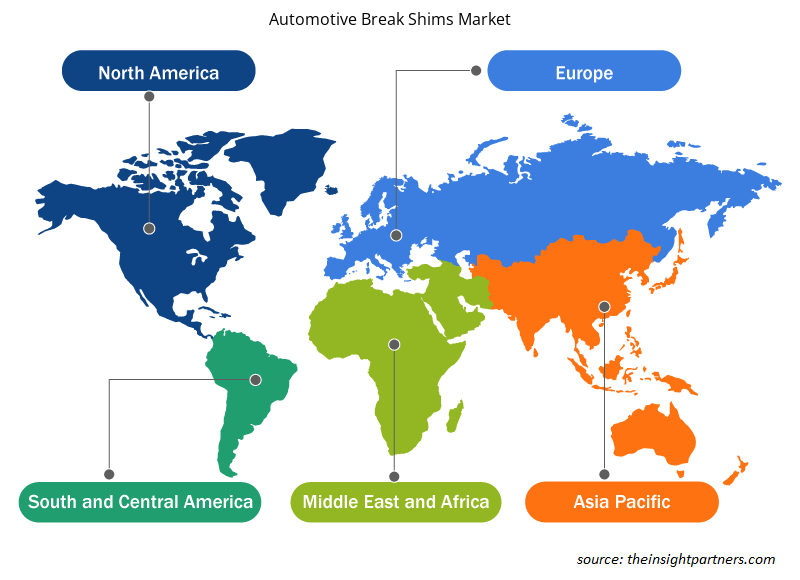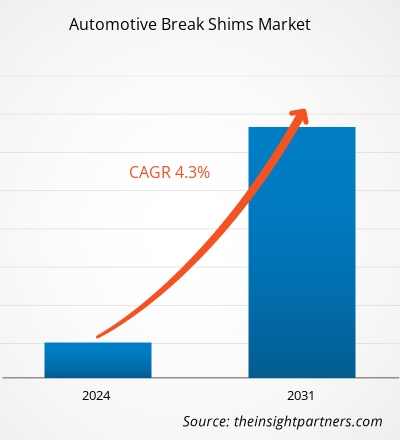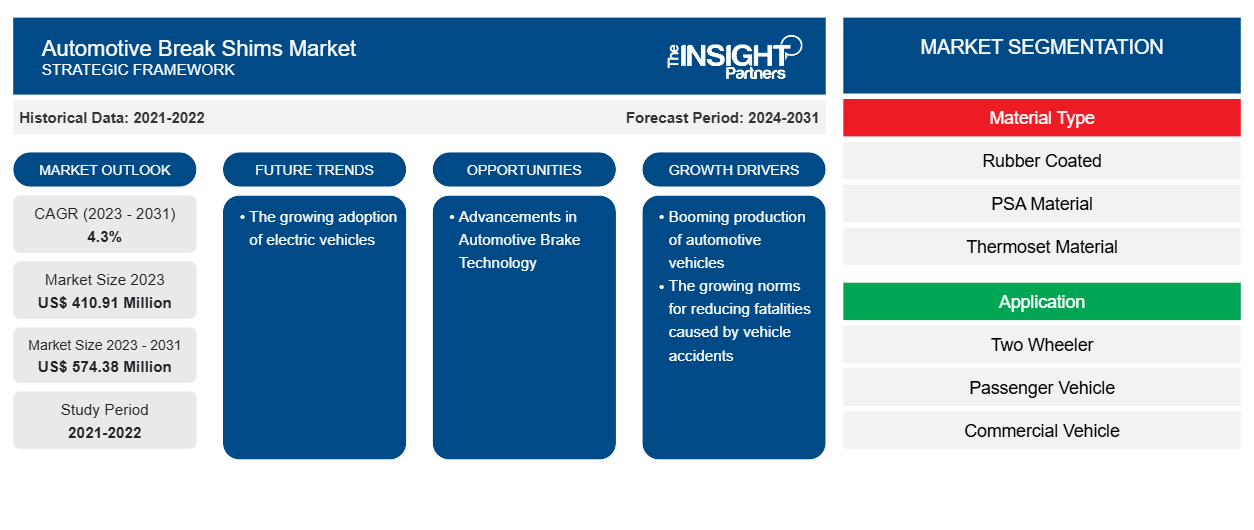Der Markt für Bremsscheiben für Kraftfahrzeuge soll von 410,91 Millionen US-Dollar im Jahr 2023 auf 574,38 Millionen US-Dollar im Jahr 2031 anwachsen. Der Markt wird zwischen 2023 und 2031 voraussichtlich eine durchschnittliche jährliche Wachstumsrate von 4,3 % verzeichnen. Die zunehmende Verbreitung von Elektrofahrzeugen wird den Markt voraussichtlich antreiben und wahrscheinlich auch weiterhin ein wichtiger Trend auf dem Markt bleiben.
Marktanalyse für Bremsscheiben für Kraftfahrzeuge
Zu den wichtigsten Akteuren im globalen Ökosystem des Marktes für Bremsscheiben für Kraftfahrzeuge gehören Materialanbieter, Hersteller von Bremsscheiben für Kraftfahrzeuge, Normungs- und Regulierungsgremien sowie Endverbraucher. Materialanbieter liefern den Herstellern von Bremsscheiben für Kraftfahrzeuge verschiedene Materialien, darunter gummibeschichtetes PSA-Material (Pressure Sensitive Adhesive), Duroplastmaterial, Titan, Stahl, Eisen, Kupfer und Graphit. Mit der weltweit steigenden Nachfrage nach Scheibenbremsen für Kraftfahrzeuge verzeichnen auch die Hersteller von Bremsscheiben für Kraftfahrzeuge eine steigende Nachfrage. Einige der wichtigsten Hersteller von Bremsscheiben für Kraftfahrzeuge sind Avery Dennison Corporation, Brembo SpA, BOSCH Auto Parts, Trelleborg Group, Meneta, Super Circle, NUCAP, Brake Performance, Delphi Technologies Plc und TEXTAR Brake Technology.
Marktübersicht für Bremsscheiben für Kraftfahrzeuge
Zu den wichtigsten Endverbrauchern des Marktes für Bremsscheiben für Kraftfahrzeuge zählen Personenkraftwagen und Nutzfahrzeuge. Scheibenbremsen werden hauptsächlich in Personenkraftwagen eingesetzt . Aufgrund ihrer stabilen Leistung bei Bremswiderstand und höheren Geschwindigkeiten finden sie jedoch zunehmend auch im Nutzfahrzeugsegment Verwendung. Trommelbremsen werden in Nutzfahrzeugen durch Scheibenbremsen ersetzt, da sie eine höhere Qualität und eine längere Lebensdauer bieten. Daher steigt die Nachfrage nach Bremsscheiben für Kraftfahrzeuge.
Passen Sie diesen Bericht Ihren Anforderungen an
Sie erhalten kostenlose Anpassungen an jedem Bericht, einschließlich Teilen dieses Berichts oder einer Analyse auf Länderebene, eines Excel-Datenpakets sowie tolle Angebote und Rabatte für Start-ups und Universitäten.
-
Holen Sie sich die wichtigsten Markttrends aus diesem Bericht.Dieses KOSTENLOSE Beispiel umfasst eine Datenanalyse von Markttrends bis hin zu Schätzungen und Prognosen.
Markttreiber und Chancen für Bremsscheiben für Kraftfahrzeuge
Wachsende Normen zur Reduzierung tödlicher Verkehrsunfälle
Die steigenden Verkäufe von Personen- und Nutzfahrzeugen fördern das Wachstum des weltweiten Marktes für Bremsscheiben für Kraftfahrzeuge. Die steigende Nachfrage nach Fahrzeugen wirkt sich positiv auf den weltweiten Produktionszyklus aus. Mit der steigenden Nachfrage nach Fahrzeugen steigt auch die Zahl der gesetzlichen Vorschriften zur Erhöhung der Fahrzeugsicherheit. Dies führt zu einem Anstieg der Nachfrage nach Scheibenbremsen , zur Verbreitung von Antiblockiersystemen und zur Ausweitung der elektronischen Stabilitätskontrolle. Daher haben Regierungsbehörden in Ländern wie Indien sicherheitskritische Komponenten in Nutz- und Personenfahrzeugen reguliert, was zu einer steigenden Nachfrage nach Bremsscheiben für Kraftfahrzeuge führt.
Darüber hinaus sind Todesfälle durch Autounfälle einer der Faktoren, die Regierungsbehörden dazu veranlassen, neue Normen für Fahrzeuge und Verkehrssicherheit einzuführen, die zur Reduzierung der Todesfälle beitragen würden. Da ein schlechtes Bremssystem eine der Ursachen für Verkehrsunfälle ist, ist die Festlegung geeigneter Normen für die Verwendung von Reibmaterialien und Bremssystemen erforderlich. Im Folgenden sind einige der von regionalen Regierungsbehörden beschriebenen Standards für Bremssysteme aufgeführt:
- Gemäß dem Artikel des LEGISLATIVE COUNSEL'S DIGEST vom Januar 2021 ist der Einsatz von Reibmaterialien mit einem Kupferanteil von über 0,5 % in Neufahrzeugen ab 2025 verboten. Unternehmen wie Akebono haben daher bereits begonnen, diese Gesetze einzuhalten. Die Abteilung des Unternehmens ist mit der Herstellung und dem Vertrieb von Reibmaterialien beschäftigt und arbeitet weltweit zusammen, um das neue Gesetz einzuhalten. Das Unternehmen hat bereits Reibmaterialien entwickelt, die im neuen Gesetz beschrieben sind.
- Neue Regeln sind auf den Markt gekommen, die sich direkt auf das Bremssystem auswirken. Seit November 2016 muss der Austausch von Bremsscheiben bei neu zugelassenen Fahrzeugen gemäß dem Qualitätsstandard ECE R90 (ECE-Regelung 90 oder Regelung 90 der Wirtschaftskommission für Europa) erfolgen. Dieser Qualitätsstandard wird in der gesamten Europäischen Union und in außereuropäischen Ländern umgesetzt. Seit dem 1. November 2016 entsprechen alle Pkw aller Modelle den Bremsscheiben und -trommeln der ECE R90. Unternehmen wie MEYLE bieten Bremsscheiben an, die bereits dem neuen Standard entsprechen. Auch AF Aftermarket hält sich an die neue ECE R90.
Solche Gesetze für Reibmaterialien und Scheibenbremsen unterstützen das Wachstum im Bereich der Bremsscheiben für Kraftfahrzeuge.
Fortschritte in der Automobilbremsentechnologie
Die kritische Komponente jedes Fahrzeugbremssystems ist der Scheibenbremsbelag. Wenn beispielsweise ein schweres Auto bei 100 km/h in wenigen Sekunden zum Stehen kommt, entstehen über 100 kW (Kilowatt) Wärme. Diese Wärme wird in die Bremsbeläge übertragen; die Temperaturen können innerhalb von Sekunden etwa 600 °C und mehr erreichen. Trotzdem muss das Bremsen sicher und sanft erfolgen, wobei Gesundheit, Sicherheit und Umwelt immer mehr im Mittelpunkt stehen. Hersteller von Scheibenbremsbelägen müssen nach Alternativen zu traditionellen Rohstoffen wie Kupfer suchen.
Neue Reibmaterialien müssen unter extremen Bremsbedingungen gut funktionieren. Bremsbeläge müssen bei wiederholtem Bremsen und plötzlichen Notbremsungen bei Wetterbedingungen wie Nässe, Trockenheit, Schlamm oder Eis das gleiche Pedalgefühl und die gleiche Verzögerung bieten. Fortschritte bei Bremsen haben für Automobilhersteller zunehmend Auswirkungen; außerdem werden verschiedene Standards eingeführt, um sicherzustellen, dass Reibmaterialien die Emissionen reduzieren. Feinstaubemissionen werden in Städten immer unerwünscht. Und selbst Elektrofahrzeuge, die regeneratives Bremsen verwenden, das Verschleiß und Emissionen reduziert, stellen ihre eigenen Anforderungen an Bremssysteme.
Segmentierungsanalyse des Marktberichts für Bremsscheiben für Kraftfahrzeuge
Wichtige Segmente, die zur Ableitung der Marktanalyse für Bremsscheiben für Kraftfahrzeuge beigetragen haben, sind Materialtyp und Anwendung.
- Basierend auf dem Materialtyp ist der Markt für Bremsscheiben für Kraftfahrzeuge in gummibeschichtete, PSA-Materialien, Duroplaste und andere unterteilt. Das Segment „Sonstige“ hatte im Jahr 2023 einen größeren Marktanteil.
- Basierend auf der Anwendung ist der Markt für Bremsscheiben für Kraftfahrzeuge in Zweiräder, Personenkraftwagen und Nutzfahrzeuge unterteilt. Das Pkw-Segment hatte im Jahr 2023 einen größeren Marktanteil.
Marktanteilsanalyse für Bremsscheiben für Kraftfahrzeuge nach geografischen Gesichtspunkten
Der geografische Umfang des Marktberichts für Bremsscheiben für Kraftfahrzeuge ist hauptsächlich in fünf Regionen unterteilt: Nordamerika, Europa, Asien-Pazifik, Naher Osten und Afrika sowie Südamerika.
Der asiatisch-pazifische Raum dominierte den Markt im Jahr 2023, gefolgt von den Regionen Europa und Nordamerika. Darüber hinaus wird der asiatisch-pazifische Raum in den kommenden Jahren wahrscheinlich auch die höchste durchschnittliche jährliche Wachstumsrate verzeichnen. China hatte im Jahr 2023 den größten Marktanteil auf dem Markt für Bremsscheiben für Kraftfahrzeuge im asiatisch-pazifischen Raum. Laut Zahlen der OICA wurden im Jahr 2023 in der gesamten Region China über 30 Millionen Fahrzeuge (Pkw und Nutzfahrzeuge) produziert, davon 26,12 Millionen Pkw. Mit dem Wachstum der chinesischen Automobilindustrie haben mehr Autohersteller ihr Verständnis und ihre Forschung und Entwicklung im Bereich Autoteile verbessert. Sie identifizieren nicht nur direkt die Lieferanten der ersten Stufe für Bremssysteme, sondern begrenzen auch die Anzahl der Bremsbelaglieferanten und die Zusammensetzung des Reibmaterials. Infolgedessen steigt Chinas Nachfrage nach Bremssystemen. Die Expansion von Unternehmen, die Bremsscheiben für Fahrzeuge herstellen, und Unternehmen, die Bremsscheiben für Aftermarket-Dienstleistungen liefern, wird durch die wachsende Nachfrage nach Bremssystemen beeinflusst. Dies hat die Nachfrage nach dem Markt für Bremsscheiben für Kraftfahrzeuge in der Region erhöht.
Regionale Einblicke in den Markt für Bremsscheiben für Kraftfahrzeuge
Die regionalen Trends und Faktoren, die den Markt für Bremsscheiben für Kraftfahrzeuge im gesamten Prognosezeitraum beeinflussen, wurden von den Analysten von Insight Partners ausführlich erläutert. In diesem Abschnitt werden auch die Marktsegmente und die Geografie für Bremsscheiben für Kraftfahrzeuge in Nordamerika, Europa, im asiatisch-pazifischen Raum, im Nahen Osten und Afrika sowie in Süd- und Mittelamerika erörtert.

- Erhalten Sie regionale Daten zum Automobil-Bremsscheibenmarkt
Umfang des Marktberichts zu Bremsscheiben für Kraftfahrzeuge
| Berichtsattribut | Details |
|---|---|
| Marktgröße im Jahr 2023 | 410,91 Millionen US-Dollar |
| Marktgröße bis 2031 | 574,38 Millionen US-Dollar |
| Globale CAGR (2023 - 2031) | 4,3 % |
| Historische Daten | 2021-2022 |
| Prognosezeitraum | 2024–2031 |
| Abgedeckte Segmente |
Nach Materialtyp
|
| Abgedeckte Regionen und Länder |
Nordamerika
|
| Marktführer und wichtige Unternehmensprofile |
|
Dichte der Marktteilnehmer für Bremsscheiben für Kraftfahrzeuge: Auswirkungen auf die Geschäftsdynamik verstehen
Der Markt für Bremsscheiben für Kraftfahrzeuge wächst rasant. Dies wird durch die steigende Nachfrage der Endnutzer aufgrund von Faktoren wie sich entwickelnden Verbraucherpräferenzen, technologischen Fortschritten und einem größeren Bewusstsein für die Vorteile des Produkts vorangetrieben. Mit der steigenden Nachfrage erweitern Unternehmen ihr Angebot, entwickeln Innovationen, um die Bedürfnisse der Verbraucher zu erfüllen, und nutzen neue Trends, was das Marktwachstum weiter ankurbelt.
Die Marktteilnehmerdichte bezieht sich auf die Verteilung der Firmen oder Unternehmen, die in einem bestimmten Markt oder einer bestimmten Branche tätig sind. Sie gibt an, wie viele Wettbewerber (Marktteilnehmer) in einem bestimmten Marktraum im Verhältnis zu seiner Größe oder seinem gesamten Marktwert präsent sind.
Die wichtigsten auf dem Markt für Bremsscheiben für Kraftfahrzeuge tätigen Unternehmen sind:
- Avery Dennison Corporation
- Brembo SpA
- BOSCH Autoteile
- Trelleborg-Gruppe
- Meneta Automotive Components Pvt. GmbH
Haftungsausschluss : Die oben aufgeführten Unternehmen sind nicht in einer bestimmten Reihenfolge aufgeführt.

- Überblick über die wichtigsten Akteure auf dem Markt für Bremsscheiben für Kraftfahrzeuge
Neuigkeiten und aktuelle Entwicklungen zum Markt für Bremsscheiben für Kraftfahrzeuge
Der Markt für Bremsscheiben für Kraftfahrzeuge wird durch die Erhebung qualitativer und quantitativer Daten nach Primär- und Sekundärforschung bewertet, die wichtige Unternehmensveröffentlichungen, Verbandsdaten und Datenbanken umfasst. Nachfolgend sind einige der Entwicklungen auf dem Markt für Bremsscheiben für Kraftfahrzeuge aufgeführt:
- Bosch und die Volkswagen-Konzerntochter Cariad gehen eine Partnerschaft ein, um die automatisierten Fahrfunktionen über alle Fahrzeugklassen hinweg zu verbessern. (Quelle: Bosch, Pressemitteilung, 2022)
- TMD Friction, die Muttergesellschaft von Textar, hat 825 neue Produkte für sein gesamtes Produktsortiment herausgebracht. Mit diesem Schritt bietet TMD Friction die größte Abdeckung aller Bremsbelaghersteller. (Quelle: TMD Friction, Pressemitteilung, 2022)
Marktbericht zu Bremsscheiben für Kraftfahrzeuge – Umfang und Ergebnisse
Der Bericht „Marktgröße und Prognose für Bremsscheiben für Kraftfahrzeuge (2021–2031)“ bietet eine detaillierte Analyse des Marktes, die die folgenden Bereiche abdeckt:
- Marktgröße und Prognose für Bremsscheiben für Kraftfahrzeuge auf globaler, regionaler und Länderebene für alle wichtigen Marktsegmente, die im Rahmen des Berichts abgedeckt sind
- Markttrends für Bremsscheiben für Kraftfahrzeuge sowie Marktdynamiken wie Treiber, Einschränkungen und wichtige Chancen
- Detaillierte PEST-Analyse
- Marktanalyse für Bremsscheiben für Kraftfahrzeuge mit Blick auf wichtige Markttrends, globale und regionale Rahmenbedingungen, wichtige Akteure, Vorschriften und aktuelle Marktentwicklungen
- Branchenlandschaft und Wettbewerbsanalyse, die die Marktkonzentration, Heatmap-Analyse, prominente Akteure und aktuelle Entwicklungen auf dem Markt für Bremsscheiben für Kraftfahrzeuge umfasst
- Detaillierte Firmenprofile
- Historische Analyse (2 Jahre), Basisjahr, Prognose (7 Jahre) mit CAGR
- PEST- und SWOT-Analyse
- Marktgröße Wert/Volumen – Global, Regional, Land
- Branchen- und Wettbewerbslandschaft
- Excel-Datensatz
Aktuelle Berichte
Erfahrungsberichte
Grund zum Kauf
- Fundierte Entscheidungsfindung
- Marktdynamik verstehen
- Wettbewerbsanalyse
- Kundeneinblicke
- Marktprognosen
- Risikominimierung
- Strategische Planung
- Investitionsbegründung
- Identifizierung neuer Märkte
- Verbesserung von Marketingstrategien
- Steigerung der Betriebseffizienz
- Anpassung an regulatorische Trends























 Kostenlose Probe anfordern für - Markt für Bremsscheiben für Kraftfahrzeuge
Kostenlose Probe anfordern für - Markt für Bremsscheiben für Kraftfahrzeuge